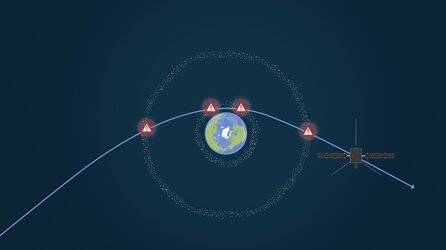Accept all cookies Accept only essential cookies See our Cookie Notice

About ESA
The European Space Agency (ESA) is Europe’s gateway to space. Its mission is to shape the development of Europe’s space capability and ensure that investment in space continues to deliver benefits to the citizens of Europe and the world.
Highlights
ESA - United space in Europe
This is ESA ESA facts Member States & Cooperating States Funding Director General Top management For Member State Delegations European vision European Space Policy ESA & EU Responsibility & Sustainability Annual Report Calendar of meetings Corporate newsEstablishments & sites
ESA Headquarters ESA ESTEC ESA ESOC ESA ESRIN ESA EAC ESA ESAC Europe's Spaceport ESA ESEC ESA ECSAT Brussels Office Washington OfficeWorking with ESA
Business with ESA ESA Commercialisation Gateway Law at ESA Careers Cyber resilience at ESA IT at ESA Newsroom Partnerships Merchandising Licence Education Open Space Innovation Platform Integrity and Reporting Administrative Tribunal Health and SafetyMore about ESA
History ESA Historical Archives Exhibitions Publications Art & Culture ESA Merchandise Kids Diversity ESA Brand Centre ESA ChampionsLatest
Space in Member States
Find out more about space activities in our 23 Member States, and understand how ESA works together with their national agencies, institutions and organisations.
Science & Exploration
Exploring our Solar System and unlocking the secrets of the Universe
Go to topicAstronauts
Missions
Juice Euclid Webb Solar Orbiter BepiColombo Gaia ExoMars Cheops Exoplanet missions More missionsActivities
International Space Station Orion service module Gateway Concordia Caves & Pangaea BenefitsLatest
Space Safety
Protecting life and infrastructure on Earth and in orbit
Go to topicAsteroids
Asteroids and Planetary Defence Asteroid danger explained Flyeye telescope: asteroid detection Hera mission: asteroid deflection Near-Earth Object Coordination CentreSpace junk
About space debris Space debris by the numbers Space Environment Report In space refuelling, refurbishing and removingSafety from space
Clean Space ecodesign Zero Debris Technologies Space for Earth Supporting Sustainable DevelopmentLatest
Applications
Using space to benefit citizens and meet future challenges on Earth
Go to topicObserving the Earth
Observing the Earth Future EO Copernicus Meteorology Space for our climate Satellite missionsCommercialisation
ESA Commercialisation Gateway Open Space Innovation Platform Business Incubation ESA Space SolutionsLatest
Enabling & Support
Making space accessible and developing the technologies for the future
Go to topicBuilding missions
Space Engineering and Technology Test centre Laboratories Concurrent Design Facility Preparing for the future Shaping the Future Discovery and Preparation Advanced Concepts TeamSpace transportation
Space Transportation Ariane Vega Space Rider Future space transportation Boost! Europe's Spaceport Launches from Europe's Spaceport from 2012Latest

Where and why we whizz around Earth
Thank you for liking
You have already liked this page, you can only like it once!
Our understanding of orbits, first established by Johannes Kepler in the 17th century, remains foundational even after 400 years. Today, Europe continues this legacy with a family of rockets launched from Europe’s Spaceport into a wide range of orbits around Earth, the Moon, the Sun and other planetary bodies.
The most commonly used Earth orbits are represented in this infographic. In these space highways, humankind has put its most advanced ears and eyes, travelling thousands of kilometres per second and looking back at Earth, out to the Sun, the Solar System and across deep space.
| Name | Altitude | Benefits | Example |
| Low Earth orbit (LEO) | Below 2000 km | Close-up, high-resolution Earth views – good for Earth observation, weather, climate and telecoms | International Space Station |
| Polar orbit (PO) | 200–1000 km | Polar orbits allow for full coverage of Earth as it rotates beneath, good for Earth observation, positioning satellites | Cryosat |
| Sun synchronous orbit (SSO) | 600–800 km | Fixed position with respect to the Sun, meaning light and shadow are consistent – good for Earth observation and monitoring long-term changes | Copernicus Sentinel constellation |
| Medium Earth orbit (MEO)
|
2000–35786 km | Optimal balance of distance and number of satellites needed for full Earth coverage | Galileo constellation |
| Geostationary transfer orbit (GTO)
|
35 786 km (apogee) | Used to place a satellite into geostationary transfer orbit | Temporary |
| Geostationary orbit (GEO)
|
35 786 km | Satellites follow the same point on Earth – good for changing weather patterns, disaster and climate tracking as well as telecommunications | European Data Relay Service |
| Highly eccentric orbit (HEO)
|
Can extend far from Earth, including comets originating in the Oort cloud | Mostly far from Earth’s radiation and shadow – good for astronomy, telecoms | XMM-Newton |
-
CREDIT
ESA -
LICENCE
ESA Standard Licence

Solar Orbiter's Earth flyby

Solar Orbiter’s riskiest flyby

In-orbit servicing mission RISE

MTG-I1 looking good after voyage















 Germany
Germany
 Austria
Austria
 Belgium
Belgium
 Denmark
Denmark
 Spain
Spain
 Estonia
Estonia
 Finland
Finland
 France
France
 Greece
Greece
 Hungary
Hungary
 Ireland
Ireland
 Italy
Italy
 Luxembourg
Luxembourg
 Norway
Norway
 The Netherlands
The Netherlands
 Poland
Poland
 Portugal
Portugal
 Czechia
Czechia
 Romania
Romania
 United Kingdom
United Kingdom
 Slovenia
Slovenia
 Sweden
Sweden
 Switzerland
Switzerland

























